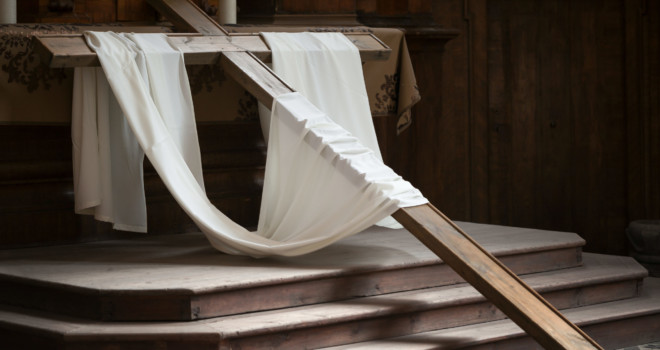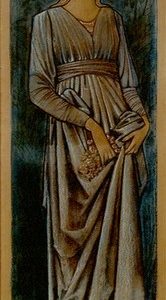Contend, O Lord, with my contenders; fight those who fight me.
— Entrance antiphon for Monday of Holy Week
Angels, Saints, and Sinners
Each of us is an individual cell of a larger corpus, or body, the Mystical Body. The ancient Greek philosopher Aristotle recognized that man by nature is a social animal. Christian faith recognizes the same truth: individuals are born into a body and are saved as members of a body. Thus, we can rely on several communities to help us reach salvation — the hierarchy of angels, the Communion of Saints, and our own sacred society here on earth.
As for the first of these, the angels, as purely spiritual creatures, possess minds and wills and constantly behold the face of God, worshipping Him, honoring Him, and serving Him. They possess an extraordinary track record as God’s commandos in the field. In the Old Covenant, for example, “they closed the earthly paradise; protected Lot; saved Hagar and her child; stayed Abraham’s hand; communicated the law by their ministry; led the People of God; announced births and callings; and assisted the prophets” (CCC 332). But their work continued into the New Testament as well, bringing great tidings to the shepherds and Mary and even poor, dumbfounded Zechariah, St. John the Baptist’s father.
Fortunately for us, they also show up for regular duty throughout Lent, in the same way they came to Christ’s aid during His forty days in the desert. We hear in the Gospel for the First Sunday of Lent that after Jesus resists the Devil’s three temptations, “angels came and ministered to him” (Matt. 4:11; Mark 1:13). At Lent’s end, the Church recounts how an angel appears to strengthen Christ in His agony in the garden (see Luke 22:43).
Saints also accompany Jesus during His earthly journey to the Paschal Mystery, just as they support us during our liturgical celebration of the same mystery. His parents, for one, were particularly holy. For example, Mary, who, following the announcement by Gabriel (another angel!), offered her fiat and ushered in a new creation, is the pinnacle of human holiness. Likewise, the “just man” (see Matt. 1:19) Joseph was found worthy and thus chosen by God to wed Mary and to guard and protect the incarnate Son of God. We can’t forget Jesus’ cousin, John the Baptist, whom the Lord proclaimed to be “the greatest ever born of women” (see Matt. 11:11; Luke 7:28). The apostles, too, served as dependable aides-de-camp for Christ during His mission on earth. Despite their slow learning (see Matt. 13:36; Luke 24:25), human weakness, and alternate bouts of fear and rashness in the face of danger, these twelve men served as supreme confidants of Christ. As saints in the making, they should remind us of ourselves, and after Pentecost they should inspire us to be men and women with a passion for mission. Moses and Elijah also appear in cameos to “game-plan” with Jesus on Mount Tabor. Such a cast of supporting Gospel characters shows that holy people radiate God and thus show the way to heavenly brilliance.
But even those not yet perfectly holy — those of us struggling along the way — are a constant support to each other. In this world, the Church will always be a mixed bag of saints and sinners — but mostly sinners. Our mutual assistance should be a great comfort for us, just as it was for Jesus, as we travel with others in the Mystical Body. Indeed, liturgically speaking, we form a bond with our fellow pilgrims and, as the Catechism notes, “in the celebration of the sacraments it is thus the whole assembly that is leitourgos, each according to his function, but in the ‘unity of the Spirit’ who acts in all” (CCC 1144). Every man, woman, and child is enlisted as a unified army in retaking the paschal bridge. No one who is successful goes it alone.
Christ
Before any prayer is spoken, Palm Sunday’s first rubric reminds us clearly: “On this day the Church recalls the entrance of Christ the Lord into Jerusalem to accomplish his Paschal Mystery.” Even the first words on the priest’s lips during the Palm Sunday liturgy remind us of the paschal project for which we’ve been praying and fasting. Following the Sign of the Cross, he introduces the Mass in these words: “Dear brethren [brothers and sisters], since the beginning of Lent until now we have prepared our hearts by penance and charitable works. Today we gather together to herald with the whole Church the beginning of the celebration of our Lord’s Paschal Mystery, that is to say, of his Passion and Resurrection.”
Even if we didn’t know where we were going on Ash Wednesday, it ought to be clear to hearing ears on this day: we accompany Jesus into Jerusalem as He continues to complete His paschal bridge.
Our task, as with those who greeted Jesus with hosannas that day, is to follow Him closely and faithfully. Such, at least, is what the Church’s liturgy tells us time and again. As the priest blesses the Sunday branches, for example, he asks God to “sanctify + these branches with [his] blessing, that we, who follow Christ the King in exultation, may reach the eternal Jerusalem through him.” Similarly, St. Athanasius (d. 373) teaches that “if we follow Christ closely we shall be allowed, even on this earth, to stand as it were on the threshold of the heavenly Jerusalem, and enjoy the contemplation of that everlasting feast.” Having entered the church after the Palm Sunday Procession, we hear the Opening Prayer summarizing these same sentiments: “Almighty, ever-living God, who as an example of humility for the human race to follow caused our Savior to take flesh and submit to the Cross, graciously grant that we may heed his lesson of patient suffering and so merit a share in his Resurrection.”
Each of Palm Sunday’s liturgical rites — the blessing of palms and the reading of the Gospel account of His triumphal entry, the procession with palms into the church, as well as the solemn proclamation of the Passion — highlights the intense preparation for the Paschal Mystery, Christ’s and ours.
Angels
and Saints
We
have seen how the angels and saints accompanied Christ during His earthly
Passover and how they accompany us today. This heavenly host receives an
honorable mention during Lent, and it is called upon to assist us now as it
supported Christ during His Passover.
The Church suggests, for example, that the entrance “song” on Lent’s first Sunday be the Litany of the Saints: “In the Mass of this Sunday, there should be some distinctive elements that underline this important moment (e.g., the entrance procession with litanies of the saints).” In addition, throughout Lent’s Sundays, the Roman Missal recommends the traditional “Stational Mass” with the diocesan bishop. At such Masses, ideally beginning at a location other than the main church where Mass will be celebrated, the bishop leads the whole body of the faithful in procession while “the Litany of the Saints is sung. Invocations to the Patron Saint or the Founder Saint and to the Saints of the local Church may be inserted.” In Holy Week, during the initiation of the elect (that is, those to be baptized), the Litany of the Saints is prayed once again. In each of these instances, we find the saints coming to our aid as angels and holy ones assisted Christ.
Perhaps our first inclination is to remember only those who oppose Christ in these darkest hours: Judas, Peter and the apostles, Pilate, Herod, the centurions, the scribes and Pharisees. But the Passion narratives read on Palm Sunday (and again on Good Friday), when heard carefully, reveal a great many who assist Christ: an angel strengthens Jesus in the Garden of Gethsemane (Luke 22:43), Simon of Cyrene helps carry His Cross (Matt. 27:32; Mark 15:21; Luke 23:26), women follow Him from Jerusalem up Calvary’s hill (Luke 23:27), the centurion proclaims His innocence and divinity (Matt. 27:54; Mark 15:39; Luke 23:47), the good thief announces His power to save (Luke 23:40–42), the saints rise from their graves at His death and “enter the holy city” (Matt. 27:51–53), Joseph of Arimathea buries his body (Matt. 27:57–60; Mark 15:43; Luke 23:50–52), and Mary Magdalene looks on in sorrow and prayer (Matt. 27:61; Mark 15:47; Luke 23:55–56).
Angels and saints were strong companions during Christ’s historical bridge building, and they are equally present and powerful to us today. Their presence is announced through the Lenten liturgy’s Litanies of the Saints — who accompany a procession to the Heavenly Jerusalem — and proclamation of the Passion narratives.
✠
This article is an excerpt from a chapter in Christopher Carstens’s latest book, A Devotional Journey into the Easter Mystery. It is available as a paperback or ebook from Sophia Institute Press or your favorite bookseller.
You can find also find a free, printable summary guide to participating in the Easter Mysteries here.













